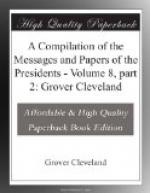The reason of the discrepancy between the real extent of the line, as actually measured, and that which formed the basis of the calculation is that the latter was made by reference to the best existing maps, which were considered to be entitled to a certain degree of credit. Upon the close examination which the operations of the late season have afforded, these maps have been ascertained to be exceedingly erroneous. Well-known streams have been found to extend in either direction many miles beyond the points at which their sources have been laid down on the maps, and great rivers and lakes have, as it were, been discovered, of which no delineation had ever been given by geographers. The extent of these errors in remote and difficultly accessible points may be inferred from what has been found to occur in the part of the region which is most accessible, best known, and most frequently traversed.
On the Temiscouata portage, a road traveled weekly by the mail of Her Britannic Majesty, continually passed by the officers of her various services, which had been carefully surveyed by civil engineers preparatory to its reconstruction, and which has been traveled by the surveyors of both countries under the joint commission, it had hitherto been believed, and it was so represented on all maps, both English and American, that the line dividing the waters crossed the road three times. The surveys of the late season show that the boundary claimed by the United States crosses this road five times, and it became necessary to explore the culminating points of the valleys of four streams, instead of two, as had been anticipated. Instances of the same sort, but which do not admit of verbal description, have occurred on every part of the lines of highlands.
The two commissioners whose operations are under consideration no doubt had it in their power to have suspended their operations and returned so soon as the portion of the appropriation placed at their disposal was so far exhausted as to leave no more than would be needed to complete their office work; but they feel satisfied that they would not have been justified in so doing so long as any portion of the line remained unsurveyed or the weather would permit a party to keep the field. Thus, although in the original plan for the partition of the work it was estimated that their lines would probably be connected in the parallel of the river Ouelle, about 30 miles south of Temiscouata portage, when it was found that, from unforeseen delays in the transportation of the party of J. Renwick by sea to their work, and on the river St. Lawrence from one station to another, it became doubtful whether he could pass the Temiscouata portage before the woods became impassable, his colleague continued his parties in the field until the junction was effected. In this way, while the expenses of the division of J. Renwick have not been materially diminished, those of the division of A. Talcott have been largely increased; but a portion of the general work has been accomplished which might otherwise have been left incomplete.




